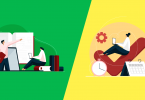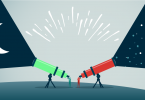
There is always a gray line between using original ideas and adding your own to them to create a new idea AND to use the original idea as it is.
While attribution is needed in both scenarios, people often don’t attribute when deriving an original work and labeling it as their own.
In this article, we will share the latest updates on the correct way to derive existing material for your courses and how to attribute them legally. With your eLearning courses serving the international student body, it is better to be safe than sorry!
I can recall many instances of copyright infringement in terms of derivative works on an international level. With the world still undivided on the language frontier, derivative works are more common than we can imagine.
Having read so many Stephen King, Sydney Sheldon, Nora Roberts and many others, I feel a sense of déjà vu when I see a derivative movie based on the novel. Many times, the author of the book on which the movie is based is never mentioned. This tells me that the movie producers had purchased exclusive rights to the “originality” of the idea of the movie.
On the contrary, movies like Harry Porter and Lord of the Rings famously attribute derivative works to their authors, linking the movies intimately to them. This invariably helps with marketing, especially if the movie is made as a series.
The basic criteria for creating derivative works
According to the US Copyright Protection documents, there are two ways in which a copyright work can be derived for commercial use:
1. Receive permission from the original author on copyright works for derivation.
2. Derive works that are a part of public domain.
These are the instances of the different types of derivative works and their examples:
- A motion picture based on a play or novel (Pride and Prejudice)
- A translation of a novel written in English into another language (Inkheart by German author Cornelia Funke)
- A revision of a previously published book (The Bible Testaments)
- A sculpture based on a drawing (Statue of Liberty)
- A drawing based on a photograph (Artists impressions on photographs)
- A lithograph based on a painting (example of Presidents Obama’s lithograph in the YouTube Derivative Works (in Copyright Law)
- A drama about John Doe based on the letters and journal entries of John Doe (Movie based on the diary of Abraham Lincoln)
- A musical arrangement of a preexisting musical work (background music copied by different countries to compose songs in their own language)
- A new version of an existing computer program (simplified computer programs for children)
- An adaptation of a dramatic work (The remake of the movie Cinderella)
- A revision of a website (customizing a website for personal business)
An overview of the documents and circumstances that allow materials to be found in the public domain
Items usually falling in the public domain are historical works of deceased authors. These are archived works found in libraries and online repositories. Many authors create original work only to share it with the public for free use.
These are mainly for educational purposes. Latest works in the public domain can also be used for marketing a cause or a business. Several “open source” computer programs build and maintain a community of programmers who constantly use the software and improve it based on their needs.
A good place to find how original and copyright works enter the public domain is at the online site: Copyright Term and the Public Domain in the United States 1 January 2015.
Research concerning exclusive right to create derivative works; especially derivative works delivered in an online environment
The copyright for derived works based on copyrighted material or public domain material is limited to the “spin off” material. Any work that is new or original in the derived work can receive copyright.
A very good example here is the derivative works based on extant research literature on any topic. In the field of education, many researchers have improved or built upon the research experiments of previous authors.
We see them attributing the previous authors rigorously throughout their work. We also see them presenting their original discoveries based on previous researches. Most of the journals with these examples are available online through membership.
An interesting practice when using two different research papers created by the same author in different times, is to attribute their work using their name as – Collins (2000) and Collins (2015).
Perhaps the online environment has the most strict rules in attributing copyright works. Public domain works attributed in copyright works are to be attributed in the exact same way as they appear in the paper being used for a study. The several formats of citing and attributions like APA, MLA, Chicago and Harvard to name a few, stress the significance of attributing all works in an appropriate manner.
All newly created derivative works need to declare the new material amended to the original works, the year of completion, the time of publication (distribution of derivative works) and the names of the original as well as the authors who re-created the work. Make sure you create this information for your eLearning courses for legal safety of your organization.
Analysis of special considerations for educational institutions
The main issues in the online educational environment is the translation of an original course into the local language. Local institutions that provide translations of original notes and lectures from international institutes need to declare the original authors to their students.
This will promote fair use of the material. It will also encourage the students to look for more material created by the original author.
Institutes should also educate their students of the Berne Convention Implementation Act of 1988: The Berne Convention formally mandated several aspects of modern copyright law; it introduced the concept that a copyright exists from the moment that a work is “fixed”, rather than requiring registration. It also enforces a requirement that countries recognize copyrights held by the citizens of all other signatory countries.
Knowledge of international fair use of copyright works will encourage you to develop and distribute their own research work with confidence.
For an educational or a research institute to be safe from any legal sanctions dealing with copyright laws, the practice of investigating the copyright status of each item used should be made common. Make sure that your eLearners receive reminders and short tutorials on citing copyright material appropriately.
In fact, create a short tutorial on copyright and derivative works to be included in your learning management system for free viewing!




